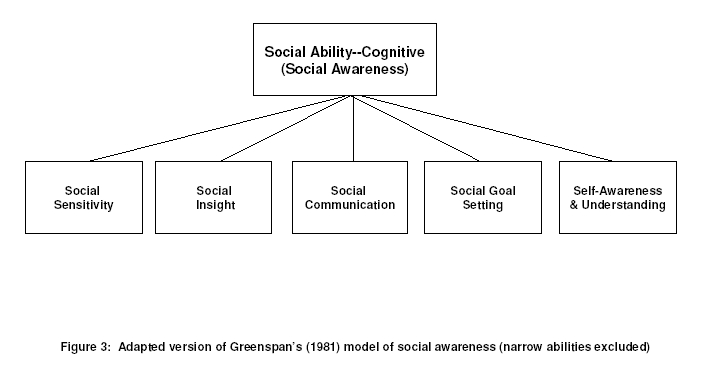In the area of cognitive social abilities, Stephen
Greenspan’s theoretical/conceptual model of personal
competence has been most prominent. Building on the tradition
of Edgar Doll’s (Doll, 1941) definition of mental
retardation, which included “social incompetence” as
one of six criteria, Greenspan (Cunningham, 1997; Greenspan &
Driscoll, 1997; Greenspan & Granfield, 1992) has argued that
the components of personal competence associated with social
awareness or intelligence have been overlooked in definitions of
individuals with mental retardation.
Greenspan’s “Model of Personal
Competence”, first articulated in 1981, emphasizes the need
for individuals working with individuals with disabilities to pay
as much attention to social awareness as is paid to cognitive
abilities (i.e., intelligence) and adaptive behavior. Although
Greenspan’s taxonomy has undergone a number of revisions over
a span of approximately 25 years (including revisions back to prior
models), the basic structure remains a powerful influence on the
work of researchers in the area of social competence and cognitive
social ability. For example, the Greenspan model has played a
prominent role in recent professional and scholarly attempts to
define mental retardation (Conyers et al., 2002; Jacobson &
Mulick, 1996; Schalock & Braddock, 1999; Thompson, McGrew,
& Bruininks, 2002). Although Greenspan’s
conceptualization of social competence, social awareness, and/or
social intelligence has morphed in various directions over the
years, we use his 1985 model of social awareness as the cognitive
dimension of social/interpersonal ability in this paper. A
schematic representation of an adapted Greenspan social awareness
model is presented in Figure 3.

“Social awareness [italics added] may be
defined as the individual’s ability to understand people,
social events, and the processes involved in regulating social
events. The emphasis on interpersonal understanding as the
core operation in social awareness indicates that this construct is
a cognitive component of human competence” (Greenspan, 1981a,
p. 18). Greenspan’s social awareness taxonomy is
divided into the 3 broad domains of social sensitivity, social
insight, and social communication.
Greenspan views social sensitivity as a
person’s ability to correctly interpret the meaning of a
social object or event. Subsumed under the umbrella of social
sensitivity are the subdomains of role-taking (ability to
understand the viewpoint and feelings of others) and social
inference (ability to correctly interpret social situations).
Social insight “may be defined as the individual’s
ability to understand the processes underlying social events and to
make evaluative judgments about such events” (Greenspan,
1981a, p. 20). Subsumed under social insight are the narrower
abilities of social comprehension (“ability to understand
social institutions and processes” [Greenspan, 1981a, p.
20]), psychological insight (ability to interpret and understand
one’s personal characteristics and motivations), and moral
judgment (ability to evaluate and make judgments about another
individual’s social actions in relation to moral and ethical
principles). Social communication, the final broad social
awareness domain in Greenspan’s model, is defined as
“the individual’s ability to understand how to
intervene effectively in interpersonal situations and influence
successfully the behaviors of others” (Greenspan, 1981a, p.
21). Components of social communication include referential
communication (ability of an individual to relate his/her feelings,
thoughts, and perceptions to others) and social problem-solving
(ability to understand how to influence the behavior of others in
order to attain a desired outcome).
Greenspan’s taxonomy, which in reality is
more of a working model, provides much needed structure to a domain
(social competence) that has often been marked by confusion and
debate over what social competence encompasses, how best to define
it, and what to call it. Given that the “hardening of
the categories” in the social awareness domains has yet to
occur, we have added, based on the current literature review, an
additional social cognitive ability to the Greenspan model
represented in Figure 3.
Drawing from the previously discussed literature
on social-cognitive models of motivation, social goal-setting has
been identified as an important student characteristic related to
school learning. According to Wentzel, (2002), the day-to-day
experiences of children raise many socially related questions
(e.g., How and why children strive to achieve social
outcomes?, What type of social goal setting
occurs?).
Social goal setting is defined as the setting of
goals to achieve specific social outcomes (e.g., making friends) or
to interact with others in certain ways (e.g., assisting someone
with a task). A major social cognitive challenge for
children, particularly for some children with disabilities, is the
setting of social goals in pursuit of peer acceptance and avoidance
of social conflict (Parkhurst & Asher, 1985). This is a
challenging task given the inherently ill-defined, complex, and
nuanced world of social situations (e.g., classrooms). Research
linking pro-social goal- setting and school success and adjustment
indicates that social goal-setting should be considered as one of
the many MACM domains (Covington, 2000; Wentzel,
2002).

